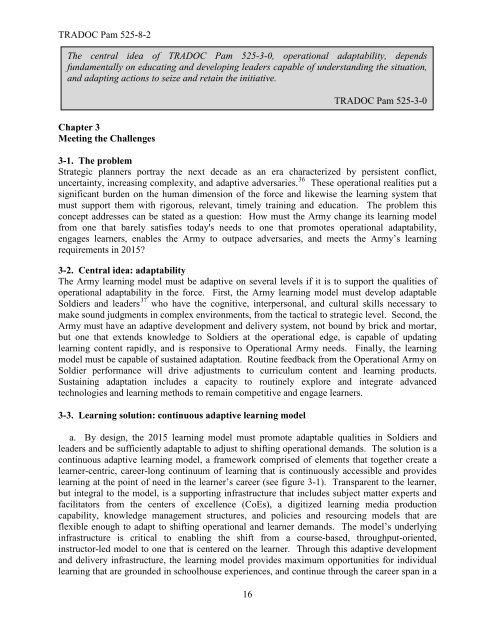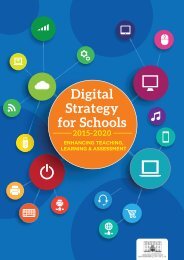K3zgZ
K3zgZ
K3zgZ
You also want an ePaper? Increase the reach of your titles
YUMPU automatically turns print PDFs into web optimized ePapers that Google loves.
TRADOC Pam 525-8-2<br />
The central idea of TRADOC Pam 525-3-0, operational adaptability, depends<br />
fundamentally on educating and developing leaders capable of understanding the situation,<br />
and adapting actions to seize and retain the initiative.<br />
Chapter 3<br />
Meeting the Challenges<br />
3-1. The problem<br />
Strategic planners portray the next decade as an era characterized by persistent conflict,<br />
uncertainty, increasing complexity, and adaptive adversaries. 36 These operational realities put a<br />
significant burden on the human dimension of the force and likewise the learning system that<br />
must support them with rigorous, relevant, timely training and education. The problem this<br />
concept addresses can be stated as a question: How must the Army change its learning model<br />
from one that barely satisfies today's needs to one that promotes operational adaptability,<br />
engages learners, enables the Army to outpace adversaries, and meets the Army’s learning<br />
requirements in 2015?<br />
3-2. Central idea: adaptability<br />
The Army learning model must be adaptive on several levels if it is to support the qualities of<br />
operational adaptability in the force. First, the Army learning model must develop adaptable<br />
Soldiers and leaders 37 who have the cognitive, interpersonal, and cultural skills necessary to<br />
make sound judgments in complex environments, from the tactical to strategic level. Second, the<br />
Army must have an adaptive development and delivery system, not bound by brick and mortar,<br />
but one that extends knowledge to Soldiers at the operational edge, is capable of updating<br />
learning content rapidly, and is responsive to Operational Army needs. Finally, the learning<br />
model must be capable of sustained adaptation. Routine feedback from the Operational Army on<br />
Soldier performance will drive adjustments to curriculum content and learning products.<br />
Sustaining adaptation includes a capacity to routinely explore and integrate advanced<br />
technologies and learning methods to remain competitive and engage learners.<br />
3-3. Learning solution: continuous adaptive learning model<br />
a. By design, the 2015 learning model must promote adaptable qualities in Soldiers and<br />
leaders and be sufficiently adaptable to adjust to shifting operational demands. The solution is a<br />
continuous adaptive learning model, a framework comprised of elements that together create a<br />
learner-centric, career-long continuum of learning that is continuously accessible and provides<br />
learning at the point of need in the learner’s career (see figure 3-1). Transparent to the learner,<br />
but integral to the model, is a supporting infrastructure that includes subject matter experts and<br />
facilitators from the centers of excellence (CoEs), a digitized learning media production<br />
capability, knowledge management structures, and policies and resourcing models that are<br />
flexible enough to adapt to shifting operational and learner demands. The model’s underlying<br />
infrastructure is critical to enabling the shift from a course-based, throughput-oriented,<br />
instructor-led model to one that is centered on the learner. Through this adaptive development<br />
and delivery infrastructure, the learning model provides maximum opportunities for individual<br />
learning that are grounded in schoolhouse experiences, and continue through the career span in a<br />
16<br />
TRADOC Pam 525-3-0




